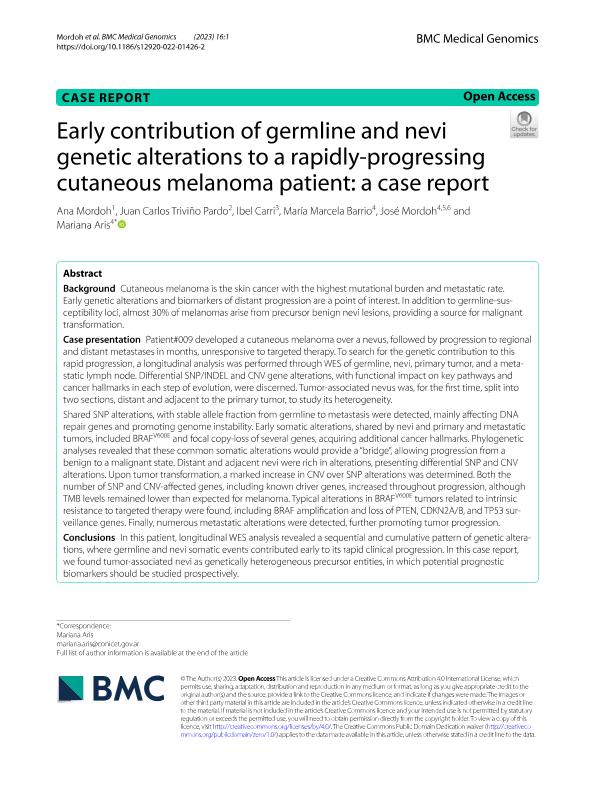Mostrar el registro sencillo del ítem
dc.contributor.author
Mordoh, Ana
dc.contributor.author
Triviño Pardo, Juan Carlos
dc.contributor.author
Carri, Ibel

dc.contributor.author
Barrio, Maria Marcela

dc.contributor.author
Mordoh, Jose

dc.contributor.author
Aris, Mariana

dc.date.available
2023-12-04T14:52:59Z
dc.date.issued
2023-01
dc.identifier.citation
Mordoh, Ana; Triviño Pardo, Juan Carlos; Carri, Ibel; Barrio, Maria Marcela; Mordoh, Jose; et al.; Early contribution of germline and nevi genetic alterations to a rapidly-progressing cutaneous melanoma patient: a case report; BioMed Central; Bmc Medical Genomics; 16; 1; 1-2023; 1-9
dc.identifier.issn
1755-8794
dc.identifier.uri
http://hdl.handle.net/11336/219197
dc.description.abstract
Background: Cutaneous melanoma is the skin cancer with the highest mutational burden and metastatic rate. Early genetic alterations and biomarkers of distant progression are a point of interest. In addition to germline-susceptibility loci, almost 30% of melanomas arise from precursor benign nevi lesions, providing a source for malignant transformation. Case presentation: Patient#009 developed a cutaneous melanoma over a nevus, followed by progression to regional and distant metastases in months, unresponsive to targeted therapy. To search for the genetic contribution to this rapid progression, a longitudinal analysis was performed through WES of germline, nevi, primary tumor, and a metastatic lymph node. Differential SNP/INDEL and CNV gene alterations, with functional impact on key pathways and cancer hallmarks in each step of evolution, were discerned. Tumor-associated nevus was, for the first time, split into two sections, distant and adjacent to the primary tumor, to study its heterogeneity. Shared SNP alterations, with stable allele fraction from germline to metastasis were detected, mainly affecting DNA repair genes and promoting genome instability. Early somatic alterations, shared by nevi and primary and metastatic tumors, included BRAFV600E and focal copy-loss of several genes, acquiring additional cancer hallmarks. Phylogenetic analyses revealed that these common somatic alterations would provide a “bridge”, allowing progression from a benign to a malignant state. Distant and adjacent nevi were rich in alterations, presenting differential SNP and CNV alterations. Upon tumor transformation, a marked increase in CNV over SNP alterations was determined. Both the number of SNP and CNV-affected genes, including known driver genes, increased throughout progression, although TMB levels remained lower than expected for melanoma. Typical alterations in BRAFV600E tumors related to intrinsic resistance to targeted therapy were found, including BRAF amplification and loss of PTEN, CDKN2A/B, and TP53 surveillance genes. Finally, numerous metastatic alterations were detected, further promoting tumor progression. Conclusions: In this patient, longitudinal WES analysis revealed a sequential and cumulative pattern of genetic alterations, where germline and nevi somatic events contributed early to its rapid clinical progression. In this case report, we found tumor-associated nevi as genetically heterogeneous precursor entities, in which potential prognostic biomarkers should be studied prospectively.
dc.format
application/pdf
dc.language.iso
eng
dc.publisher
BioMed Central

dc.rights
info:eu-repo/semantics/openAccess
dc.rights.uri
https://creativecommons.org/licenses/by/2.5/ar/
dc.subject
CANCER HALLMARKS
dc.subject
CANCER PATHWAYS
dc.subject
CASE REPORT
dc.subject
CUTANEOUS MELANOMA
dc.subject
GERMLINE ALTERATIONS
dc.subject
NEVI HETEROGENEITY
dc.subject
SOMATIC ALTERATIONS
dc.subject
TUMOR PROGRESSION
dc.subject
WHOLE-EXOME SEQUENCING
dc.subject.classification
Oncología

dc.subject.classification
Medicina Clínica

dc.subject.classification
CIENCIAS MÉDICAS Y DE LA SALUD

dc.title
Early contribution of germline and nevi genetic alterations to a rapidly-progressing cutaneous melanoma patient: a case report
dc.type
info:eu-repo/semantics/article
dc.type
info:ar-repo/semantics/artículo
dc.type
info:eu-repo/semantics/publishedVersion
dc.date.updated
2023-12-04T11:37:26Z
dc.journal.volume
16
dc.journal.number
1
dc.journal.pagination
1-9
dc.journal.pais
Reino Unido

dc.journal.ciudad
Londres
dc.description.fil
Fil: Mordoh, Ana. Universidad de Buenos Aires. Facultad de Medicina. Hospital de Clínicas General San Martín; Argentina
dc.description.fil
Fil: Triviño Pardo, Juan Carlos. Sistemas Genómicos Grupo Biomédico ASCIRES; España
dc.description.fil
Fil: Carri, Ibel. Universidad Nacional de San Martín. Instituto de Investigaciones Biotecnológicas. - Consejo Nacional de Investigaciones Científicas y Técnicas. Oficina de Coordinación Administrativa Parque Centenario. Instituto de Investigaciones Biotecnológicas; Argentina
dc.description.fil
Fil: Barrio, Maria Marcela. Consejo Nacional de Investigaciones Científicas y Técnicas; Argentina. Fundación Cáncer. Centro de Investigaciones Oncológicas; Argentina
dc.description.fil
Fil: Mordoh, Jose. Consejo Nacional de Investigaciones Científicas y Técnicas. Oficina de Coordinación Administrativa Parque Centenario. Instituto de Investigaciones Bioquímicas de Buenos Aires. Fundación Instituto Leloir. Instituto de Investigaciones Bioquímicas de Buenos Aires; Argentina. Instituto Alexander Fleming; Argentina. Fundación Cáncer. Centro de Investigaciones Oncológicas; Argentina
dc.description.fil
Fil: Aris, Mariana. Consejo Nacional de Investigaciones Científicas y Técnicas; Argentina. Fundación Cáncer. Centro de Investigaciones Oncológicas; Argentina
dc.journal.title
Bmc Medical Genomics

dc.relation.alternativeid
info:eu-repo/semantics/altIdentifier/url/https://bmcmedgenomics.biomedcentral.com/articles/10.1186/s12920-022-01426-2
dc.relation.alternativeid
info:eu-repo/semantics/altIdentifier/doi/http://dx.doi.org/10.1186/s12920-022-01426-2
Archivos asociados
